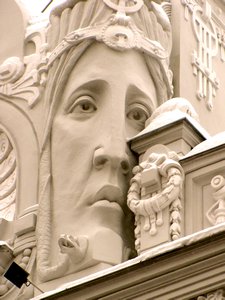Advertisement
Published: March 10th 2010

 Art Nouveau Bldg. Face
Art Nouveau Bldg. Face
The detail on the buildings was amazing, intricate and beautiful
YOU CAN CLICK ON 'PREVIOUS ENTRIES' AT THE TOP LEFT OF THIS BLOG PAGE AND SEE OTHER BLOG ENTRIES. Riga, Latvia - January 28 through 31, 2010
We had but a short visit to Riga, but a winter-wonderland one. Bernard was attending a seminar in his field, International Humanitarian Law, and also delivered a short lecture. Since Bernard was busy with his seminar, I had loads of time to walk around this picturesque old city - our hotel was within walking distance of all the sights.
It was very cold, snowed almost constantly, but one afternoon it was clear - you'll notice the difference in the photos. On the clear day I stayed out all day taking photos and it wasn't even very cold. I thought I'd have to make numerous stops in shops and for hot chocolate, but alas I did

 Art Nouveau Bldg. at Alberta 13
Art Nouveau Bldg. at Alberta 13
Alberta street has many of the wonderful art nouveau buildings, many of which are apartments now, or businesses. Bernie's seminar took place in one of these amazing buildingsnot.
Accommodations
We stayed in a lovely old mansion that had been recently renovated into a small hotel - it was just fabulous and we got a very good rate. The hotel where most of the other conference attendees were staying (and where the organizers hosted an outrageous eight-course dinner for us all) was the best in town, and also the most expensive. Since we wanted to stay two extra days, we choose an alternative hotel and couldn’t have been more pleased. It was around the corner from the ritzy hotel, but half the price - even off-setting the days that would have been paid for by the organizers, ours was the better value.
Most of the attendees of the conference stayed an extra day, so the organizers put together a really nice tour - we saw many of the Art Nouveau buildings, drove through neighborhoods to see how the normal folk lived, went out of town to the Mother Latvia Memorial, and toured several museums. We were so very glad to have a warm bus to retreat to occasionally as it was bitterly cold that day.
The City
Riga is the big boy of

 Riga Street Light
Riga Street Light
These street lights were up and down the entire street at irregular heights and spacing - wonderful!the Baltics - a major metropolis with a big-city atmosphere. In the 1930s it was the West’s major post for listening to the ‘Russian bear’ to the east, and the city became a mix of diplomats, traders and intrigue, earning it the name ‘Paris of the east.’ Riga’s postcard-pretty historic old quarter is a Unesco World Heritage Site, and its collection of stunning Art Nouveau architecture is Europe’s finest.
A fascinating mix of Latvian, Russian and German influences, Riga has changed dramatically since independence (1991). More office blocks and swanky hotels are sprouting up everywhere, the restaurant scene is glitzy. The city held its 800th birthday party in 2001.
Ethnic Mix
Fewer than half of Riga’s residents are ethnic
Latvians (41%!i(MISSING)n 2001), with Russians accounting for nearly 44%!o(MISSING)f the population. Despite Latvians being a minority in their own capital, there doesn’t seem to be much ethnic strife.
History
Riga was founded in 1158 as a river-mouth storehouse for German merchants. In 1201 a German fort was founded here - the first in the Baltic. The
Knights of the Sword, who made Riga their base for subjugating Livonia, set themselves up in Riga as

 House of the Blackheads w/St. Peters
House of the Blackheads w/St. Peters
This architectural gem (on right) - see next photo for front view - was build in 1344 for the Blackhead's guild of unmarried merchants. It was damaged in 1941, flatted by the Soviets seven years later, and rebuilt from scratch in 2000. It is now a museum.well. Riga became an important fortified port and joined the Hanseatic League in 1282.
After the Knights of the Sword’s decline in the 16th century, Riga fell under Polish, Swedish and then (in 1710) Russian control, albeit still dominated by the old German nobility. Riga grew into an important trading city and by WWI it was Russia’s third most important industrial city and the world’s greatest timber port.
Riga was seriously damaged in WWI and WWII. The Germans departed in 1939. After WWII, the city was turned into a soviet industrial center, becoming the main source of the USSR’s railway engines and carriages, and a big supplier of radio, telephone exchanges and computers.
Our
overall impression of Riga was of a lovely, picturesque and yet very livable city - nice restaurants and shops, clean streets, friendly people of which the young almost all speak English. They speak Russian also because of so many Russians still living there, but Russian is no longer required in schools, now Latvian is - that was not the case under Soviet rule. After independence Latvia refused to make Russian a second official language - it was a matter of principles to them.

 House of the Blackheads
House of the Blackheads
Front View - amazingly intricate and beautiful
Advertisement
Tot: 0.11s; Tpl: 0.026s; cc: 13; qc: 25; dbt: 0.0425s; 1; m:domysql w:travelblog (10.17.0.13); sld: 1;
; mem: 1.1mb


























Carlos
non-member comment
Que lindo!!
Que lindo!!! Guys what a beatitul city!! Incredible!! All the best to you!!! and keep travelling and sending great picture!! I really enjoy them!! :) Abrazoooooo